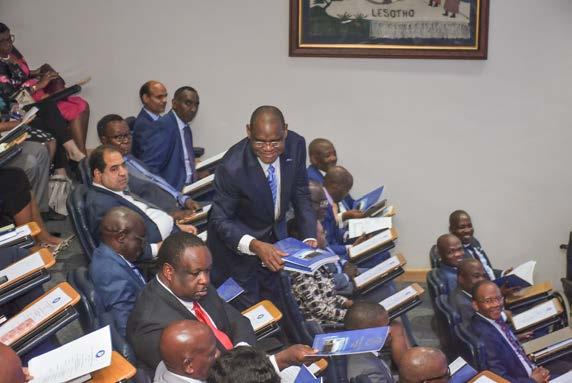
7 minute read
2020 Monetary Policy Statement Launch
from BANKNOTES
On February 25, 2020, the Bank launched the 2020 Monetary Policy Statement (MPS), which the Governor, Moses Pelaelo presented to the Minister of Finance and Economic Development, Dr Thapelo Matsheka.
BoB Governor, Moses Pelaelo handing over the Monetary Policy Statement to the Minister of Finance and Economic Development, Dr. Thapelo Matsheka Governor Moses Pelaelo interacting with guests during the launch of the Monetary Policy Statement
Advertisement


The launch and dissemination of the Monetary Policy Statement are key elements of good governance, transparency and accountability in the formulation and implementation of monetary policy. In his presentation, the Governor stated that this is intended to promote an understanding of the monetary policy framework and its objectives. It is also to guide the public’s inflation expectations towards convergence with the Bank’s inflation objective; enhancing prospects for sustained maintenance of low, stable and predictable inflation. Specifically, the Bank uses the Monetary Policy Statement as an instrument to report on the inflation trajectory and policy performance in the past year; to outline and convey its prognosis of economic and other policy developments going forward; and, in turn, the prospective monetary policy response in the ensuing year.
The Governor went on to state that, the objective of the Bank’s monetary policy was to achieve price stability, defined as a low, stable and predictable level of inflation within 3 – 6 percent, in the medium term. Monetary policy formulation was also aligned to safeguarding the stability of the financial system. In this regard, price stability, as well as conducive monetary and financial conditions foster mobilisation of savings, productive investment, prudent allocation of credit and international competitiveness of domestic firms. In turn, a sound and stable financial system is critical for effective transmission of monetary policy signals, facilitating the flow of funds and liquidity, as well as risk mitigation in support of economic activity. Overall, the conduct of monetary policy and attention to financial stability support the national objectives of employment creation and sustainable economic growth. Price and financial stability also help to preserve the value of incomes and long-term savings, especially for low income earners and pensioners, with less opportunity or wherewithal to protect their incomes or generate wealth by other means.
The Governor further stated that, Global GDP growth declined to an estimated 2.9 percent in 2019 compared to 3.6 percent in 2018. The slowdown was widespread across countries and regions. Global economic performance and sentiments were negatively affected by trade tensions between the US and China, as well as uncertain prospects for Brexit. In the circumstances, global inflation eased from 3.6 percent in 2018 to 3.4 percent in 2019.
The domestic output expansion was estimated at 3.7 percent in the twelve months to September 2019, compared to 5 percent in the year to September 2018. Growth in non-mining GDP also slowed, from 5.1 percent in the year to September 2018 to 4 percent in the corresponding period ending September 2019. “The current projections suggest that domestic inflation will, in the short term, revert to and remain within the Bank’s medium-term objective range of 3 – 6 percent,” said the Governor highlighting the continuing success in containing inflation in that range by the Bank.
The Governor went on to state that, the economy continued to operate below potential. Government expenditure grew by 15.4 percent in 2019 compared to an increase of 6.6 percent in the prior year. Within this, personal emoluments rose by 14.4 percent, following the April 2019 public sector salary increase, and this would have been replicated by other major employers. Nevertheless, the impact on inflation was muted. The Governor stated that, there was significant externalisation of spending by both

OFFICIAL NEWSLETTER OF THE BANK OF BOTSWANA Issue 3 | Volume 2 | November 2020

government and the private sector, including ready availability of imports, hence moderate impact of increased government expenditure and wages on domestic prices. He went on to highlight that the short-term impact of government spending on domestic demand was moderated to the extent that a significant component involved infrastructure and capacity development. For Botswana, this type of spending tends to be import intensive. Therefore, the economic benefits of such public investments were derived in the medium to long term.
When presenting on commercial banks, the Governor stated that growth in commercial bank credit, eased marginally from 7.7 percent in 2018 to 7.6 percent in 2019, driven by a deceleration in lending to businesses, from 10 percent growth in 2018 to a contraction of 1.7 percent in 2019. For households, annual credit growth increased from 6.2 percent in 2018 to 13.8 percent in 2019, in the context of the increase in public sector wages. Likewise, faster growth was recorded for personal loans, while the increase in mortgage loans was smaller in 2019 compared to 2018. Overall, the rate of credit growth continued to be supportive of economic activity, with minimal risk to financial stability. Looking at the crawling band exchange rate, the Governor noted that, the policy has served the country well and will continue to complement monetary policy. He stated that this bodes well for maintenance of international competitiveness of domestic industries and macroeconomic stability.
The Governor highlighted that, for its part, the Bank continued to conduct monetary policy through a forecast-based policy framework, and that informed the response to deviations of inflation from the objective range, in a forward-looking manner. The analysis also involved assessment of divergence of actual output from potential output (the output gap), a primary indicator of the direction of future inflation.
In 2019, monetary policy was conducted in an environment of below-trend economic activity and a favourable medium-term inflation outlook; therefore, providing scope for maintaining an accommodative monetary policy stance in support of stronger output growth. Hence, the Bank Rate was reduced by 25 basis points, from 5 percent to 4.75 percent in August 2019. Consequently, the prime lending rate of commercial banks declined from 6.5 percent to 6.25 percent. Deposit interest rates generally increased despite the high levels of market liquidity. The increase in market liquidity that needed to be sterilised resulted in outstanding Bank of Botswana Certificates (BoBCs) of P8.6 billion in December 2019, an increase from P8.2 billion in December 2018. BoBC yields decreased following the reduction of the Bank Rate.
The Governor emphasized that the Bank continuously evaluated monetary policy framework for effectiveness and, where appropriate, made changes. In this regard, in 2019, the Bank introduced the 7-day BoBC as the main instrument for conducting monetary operations, replacing the then 14-day paper, together with what is called ‘reserves averaging’ in the determination of the Primary Reserves Requirement for banks. This was with a view to improving the efficiency of liquidity management and policy transmission. Both measures were welcomed by the market, with a positive effect as expected; that is, better liquidity management by both the Bank and commercial banks. Over time this is expected to reduce demand for excess reserves held for precautionary purposes; therefore, freeing up additional resources for productive lending by banks.
The Governor further presented on the Financial Stability Council (FSC), whose primary mandate is to coordinate macro-prudential policy analysis and respond to threats to financial stability, launched in February 2019. The FSC comprises the Ministry of Finance and Economic Development, Bank of Botswana, Non-Bank Financial Institutions Regulatory Authority and the Financial Intelligence Agency. The Governor stated that the FSC achieved three important milestones; firstly, the publication of the maiden Financial Stability Report in September 2019; secondly, adoption of macroprudential policy framework for Botswana and thirdly, initiation of consultations on prospects for establishing a Deposit Protection Fund. The continuing success in achieving price and financial stability, to which the Bank remains fully committed is expected, in the end, to involve the cooperation of all key players in the economy, including Government, parastatals and the private sector.
In his conclusion, the Governor stated that, monetary and fiscal policies were expansionary for longer, immediate and effective implementation of transformation initiatives and structural reforms (so-called policy rotation) would raise prospects for faster growth and economic diversification, needed to attain high-income status within the Vision 2036 period. In as much as prices mattered, ultimately, total factor productivity, global competitiveness of domestically produced goods and services as well as innovation and environmentally sound policies were critical for greater prosperity and social well-being of the economy.
The launch was attended by, among others, Cabinet Ministers, Leader of Opposition, Members of Parliament, Heads of Diplomatic Missions and International Organisations, Permanent Secretaries of various Government Ministries, Heads of both Financial and Non-Financial Institutions, Media Representatives, and Bank Executive Management and Board Members.



